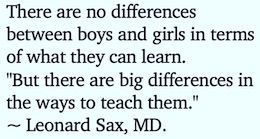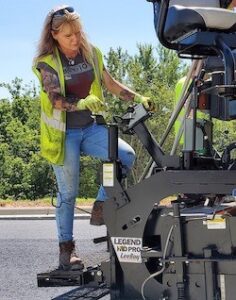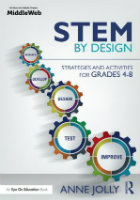Opening the Doors to Girls’ STEM Success
A MiddleWeb Blog
 Girls and STEM: The Current Dilemma
Girls and STEM: The Current Dilemma
Girls are smart, creative, and innovative – they have the right stuff for STEM careers. Yet, according to a recent report from the United States Census Bureau, women make up only 27% of the U.S. STEM workforce. That’s probably not a newsflash.
You’ve been hearing about the lack of women in STEM fields for years now, but don’t think of this as a “poor-little-girls” issue. It’s really, really important to get more girls interested in and prepared for STEM careers.
Why? Industry statistics show that U.S. technology jobs outnumbered qualified workers by roughly 4 million in 2021. Korn Ferry reports that we will be short 85 million tech workers by 2030.
85 million short just seven years from now. The growth in tech jobs is far outpacing the preparation of qualified candidates – and technology is only one STEM field.
Boosting the number of women in STEM fields would expand the nation’s pool of workers. So where are our girls? It’s time to stop wringing our hands and fix this problem.
In the interest of transparency: I’m the mother of three sons. No daughters. I’m deeply interested in seeing that boys are validated and succeed. But something is preventing our girls from choosing to pursue STEM careers, and we need to turn that around. I don’t have the answers. I’m just tossing out ideas. You’ll have better ones, so please share them at the end of this post.
Girls and STEM: Misguided Thinking and Informed Mind Shifts
Teachers have tremendous power to shape our students’ futures. As you work to empower your girls you’re going to encounter gender stereotypes, a lack of role models, and unequal access to STEM activities, among other obstacles that play a role in keeping girls out of STEM fields.
You’re familiar with some of the thinking that influences girls’ place in the STEM equation. Let’s check out six all-too-familiar statements.
1. “Girls aren’t as capable in math and science as boys.”
This destructive “math brain” myth has been repeatedly debunked. Recent research finds no differences in math ability between girls and boys. In an article titled Girls avoiding STEM, neuroscientist Nisha Cooch agrees.

That’s our cue! If girls and boys learn in different ways (keeping in mind that gender is a complex concept), how can we teach girls to better engage them in STEM? Check out these ideas.
Ask yourself:
► Do I know how girls learn? Brain science research supports our perception that girls are more nurturing and experience more complex emotions than boys. They get an earlier start in verbal and linguistic areas and thrive in social, collaborative learning environments. You’ve probably noticed that girls like to communicate and share their thoughts. Girls can relate to real-world problems and enjoy purposeful hands-on experiences.
They especially benefit from experiences that build spatial relationships and manipulation skills – an area in which they lag behind initially. That’s a starting point for thoughtfully building even more girl-friendly lessons and teaching practices. For more information on girls and learning, check out reputable online sites.
► Do I maintain an “I Can Do It” spirit in my STEM classes? (Of course, you should do this in all classes, but this is, after all, a STEM post.) Raise awareness that girls are as capable as boys in math and science (they are). Build their confidence and self-efficacy.
As girls gain confidence in their math and science abilities, the performance gap in math essentially disappears! Keep the class learning experiences upbeat and positive. Negative feedback and comments will quickly stifle your “I Can Do It!” efforts.
► Do I involve my girls’ parents? Parents often underestimate girls’ math abilities as early as preschool, and girls pick up on their parent’s expectations. If society continues to circulate myths about girls and math, and if parents unconsciously reinforce those beliefs, girls face a double whammy.
Parents can model enthusiasm for math and promote a love of math in their daughters. They can check out this post for ideas on how to promote learning at home, and take girls on field trips that promote STEM. Ditch those “I wasn’t good at math either” comments, Mom!
2. “Girls aren’t interested in STEM.”
Okay, so why aren’t they? Research does confirm that girls begin losing interest in math and science during middle school. As a STEM teacher, you need to intervene.
Ask yourself:
► Do I provide frequent collaborative learning experiences? That’s actually my number one tip for teaching girls. Since girls tend to be social learners and enjoy interacting and working with others, why do they lose interest in STEM? STEM projects feature interaction, teaming, and collaboration to solve real problems. Good STEM instruction views failure as a desirable learning experience. Girls and STEM should be a perfect fit.
Another tip that will make STEM more engaging for girls: Avoid overly competitive approaches in STEM challenges and let girls enjoy working for collective success.
► Do I create STEM leadership roles for girls? When working in teams, your eager boys are hard wired to take charge and make decisions. Girls generally acquiesce to that, so you need to make sure they participate in leadership roles and get comfortable with being leaders.
► Do I give “Women in STEM” high visibility throughout the year? In elementary and early middle grades classrooms, set up SuperGIRLS displays showing girls of all ages doing STEM work and women working in STEM fields. Add new content throughout the year and headline your girls’ accomplishments in this area. Use similar ways of promoting ongoing visibility at other grade levels.
3. “Girls don’t want STEM careers.”
Data indicate that’s correct, but why don’t they? STEM fields offer a wide range of jobs and attractive salaries. Surely girls don’t object to that! How can you reshape their thinking about STEM careers?
Ask yourself:
►Do I keep STEM careers on girls’ front burners? Start focusing on careers early in their education and don’t let up. Girls are often interested in careers that help others and make the world a better place, so be sure to spotlight STEM careers related to fields such as healthcare, environmental issues, and other careers that create better lives for people.

► Do I communicate personally with girls about possible careers? Hold conversations with your middle school girls about STEM career opportunities, including salary levels and the potential to improve things for others. Display a list of STEM career possibilities and ask girls which of these fields look important and enjoyable. Open their eyes to how exciting these fields can be! (And if you’re a male teacher – go for it! Research shows that male teachers can play a significant role in inspiring girls to become interested in STEM.)
4. “Girls don’t want to join our STEM clubs and courses.”
No problem. You can fix that. Naturally, girls feel isolated in clubs and activities where they clearly lack numbers. They want comfortable club experiences and a climate where they feel included.
Ask yourself:
► Do you advocate for a balance of boys and other girls in STEM clubs and activities?
► Do you make sure all girls you teach participate in at least one STEM activity outside of class? This might be a coding club, robotic club, SECME club, STEM fair, or other activity.
► Do you set up a “girls only” club or activity? It’s okay to do that. This can increase girls’ comfort level and willingness to be involved. It can also minimize the competitive culture and emphasize cooperation – a more comfortable and enjoyable approach for most girls. This site is an example of girls-only spaces that bring STEM alive for middle school girls.
5. “Jobs in STEM fields aren’t suited for girls.”
The contrary evidence is all around us…literally! In April 2023, NASA named the astronauts (above) who will travel to the Moon during the upcoming Artemis II mission. Among them: Christina Hammock Koch, a physicist, electrical engineer and NASA flight engineer who set a record for the longest single spaceflight by a woman (328 days in space) and participated in the first all-female spacewalk.
► Reinforce the truth that girls have the right stuff for STEM careers. Women need to be involved in designing products and solving problems, or needs and concerns unique to women may be overlooked. Girls add creativity and empathy to the workplace along with other needed skills. Tell your girls that. They don’t have to pigeonhole themselves: they are free to choose careers that interest them and make a real difference for women and for everyone.
Girls and STEM: In a Nutshell
To sum it up, being a STEM girl has big payoffs. STEM girls have higher confidence in their academic abilities than girls not interested in STEM subjects. Girls interested in STEM fields believe that they are smart and firmly believe that they can do anything boys can do. As a teacher, you can continually reinforce that belief.
The White House video Girls in STEM spotlights some extraordinary girls and their exciting STEM projects. Show this to your girls – it will make them believers.

Road worker image by Vicki White from Pixabay
Artemis II flight crew image by NASA
Feature image by Gerd Altmann from Pixabay


































Good evening Ms. Jolly, I hope this finds you doing well. I enjoy reading your blogs and, I get inspired and excited to pass along my love for STEM. I am fairly new to teaching STEM in my school. I teach grades K5 – 5th grade. The challenging part for me is coming up with a plan on what to teach. There are sooooo many STEM and STEAM lessons out there. I can spend all day researching. But, when it comes down to the school year, how do you know what to teach in a quarter, semester, or even the year? I was hoping I could get some of your thoughts or maybe you could point me in the right direction. I appreciate your time and I look forward to hearing from you. Rebecca
Hi, Rebecca! (That’s a great name – my first name is Rebecca, too.)
If you are teaching STEM at each grade level at a different time, then you can look at the course objectives for that quarter in science and math, and pick a STEM challenge that would involve students in using some of the skills in that quarter or semester. I’m not sure what your setup is – are you traveling from room to room, or do students rotate to you in your room? How long does a typical STEM lesson last? What skills do students need in order to tackle a STEM challenge? (Learning to work together successfuly in teams requires a lot of skills.)
Take a minute to browse my website, https://www.stem-by-design.com/. It’s designed for middle school teachers, but you can find plenty of ideas there. Also scroll through my other MiddleWeb blog posts – you’ll notice ideas and topics that may be of help. And keep me informed of how you’re doing!
I appreciate you taking the time to respond. The students come to me and we have 45 minute sessions. 1st – 5th visits twice a week.
I like the idea you presented about the course objectives for the quarter. I may just look into that. And thank you for the link to your site. I will definitely take a look at it.
Thank you,
Rebecca Martinez